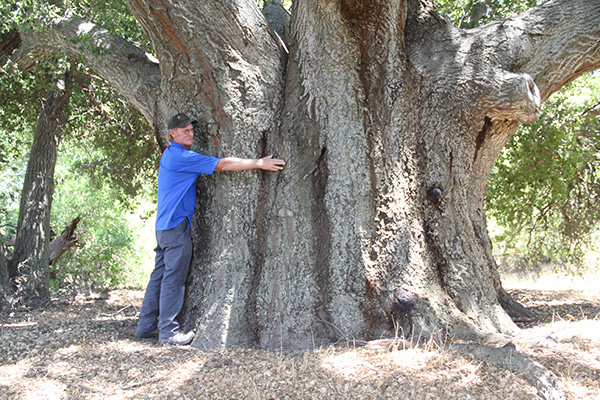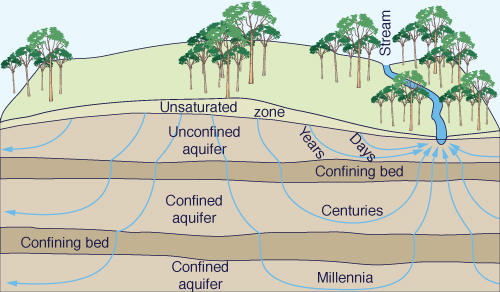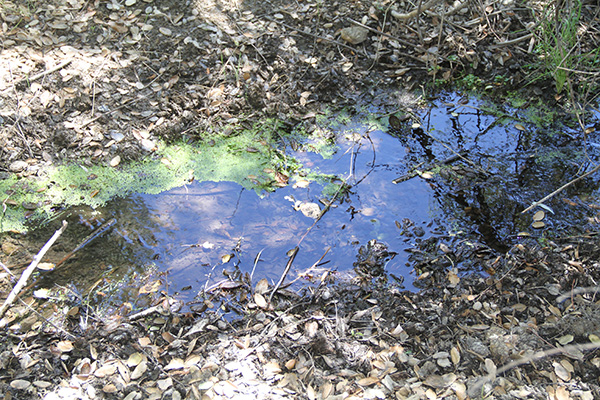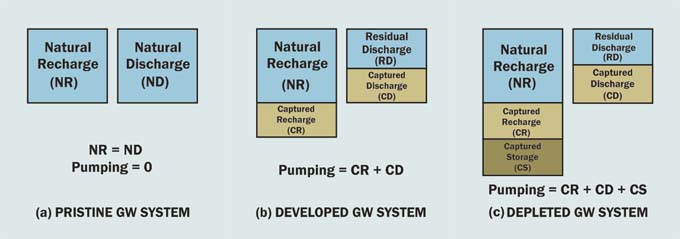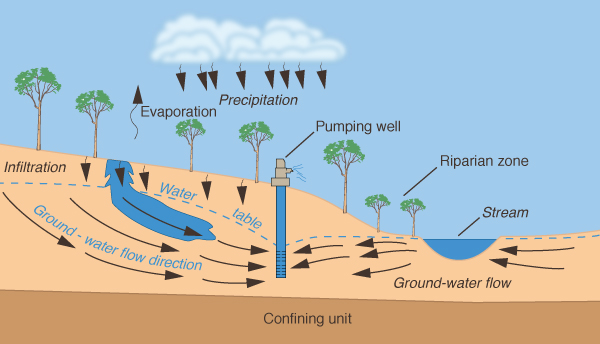The Myth of Groundwater Resource Evaluation
Skip Navigation Links
1. INTRODUCTION Groundwater lies below the ground surface at depths that vary with the prevailing climate, from very close to the surface in humid regions, to distances exceeding hundreds of meters in some very arid regions. Traditionally, human societies have relied on surface water to satisfy their varying need for water. Increasingly, however, in the past 100 years, societies have relied on groundwater by pumping it out of the ground.
Although groundwater and surface water are ultimately connected,
with one becoming the other and
The average time for renewal of groundwater is 1,400 years (World Water Balance, 1978; Ponce, 2006a). This fact alone strongly implies that the use of groundwater is a double-edged sword: Depletion typically follows any development that fails to pay heed to the timescale factor. Yet, exploitation of groundwater continues to this date, in a wide-ranging experiment with the prototype that is dominated more by economics than by physical reality. The prevailing wisdom is that groundwater exists in apparently large quantities, relatively close to the surface, and that we should use it if and when surface water becomes limiting or it is already all committed. Little attention, if any, is paid to the connectivity issue, i.e., to the fact that most groundwaters are bound to eventually become surface water. Even less attention is paid to the salinity issue: It is well known that groundwater salinity tends to increase as groundwater is pumped from increasing depths (Chebotarev, 1955; Ponce, 2012a).
Notwithstanding these recurring
issues, the past century has seen the groundwater
industry thrive, albeit mostly
in developed societies.
Groundwater resource evaluations continue to
be performed to this date in the traditional or conventional way.
Purportedly, the aim is to find how much groundwater can or may
be pumped safely. In line with current societal trends,
the dated concept of safe yield (Lee, 1915; Todd, 1959) has now given way
to the more timely sustainable yield (Alley
These issues point to the myth of groundwater resource evaluation (Bredehoeft, 1997). There is an urgent need to broaden the resource analysis to include all other aspects that have been neglected in the past. These propositions are further examined in this paper. 2. GROUNDWATER RESOURCE EVALUATION Conventional groundwater resource evaluation is based on a water budget, with the following premise: There is this amount of recharge and, therefore, we can pump that amount of groundwater; thus, the focus is on the recharge. Actually, the situation is not that simple. Under natural equilibrium conditions, recharge to a control volume is coupled with a corresponding and equal discharge from the same volume. Under developed equilibrium conditions, pumping imposes an external anthropogenic demand which draws from both recharge and discharge, increasing the former and reducing the later. Under developed non-equilibrium conditions, depletion sets in, with pumping capturing an additional volume from aquifer storage. These relations are portrayed in Fig. 3. The following statements apply:
The situation is patently clear in the case of an unconfined aquifer. Pumping from this type of aquifer lowers the groundwater levels near the well, forming a cone of depression (Fig. 4). The land surface overlying the cone is known as the area of influence of the well. Pumping changes the natural direction and amount of groundwater flow within the area of influence. The result is more recharge to the control volume and less discharge from it.
The traditional groundwater resource evaluation has sought to calculate the recharge and to limit the amount of allowable pumping to not exceed this amount. This practice has been referred to as the determination of the "safe yield." The approach, however, is flawed, because it completely disregards the existence of discharge (Sophocleous, 1997). If pursued relentlessly, it will end up drying up neighboring springs and wetlands, and eventually reduce baseflow in streams in the vicinity. Therefore, it is not sustainable (Alley et al., 1999). To illustrate the effect of "safe-yield" pumping on baseflow, Sophocleous (2000) presented two timed maps of perennial streams in Kansas, within the High Plains regional aquifer (Fig. 5). The right-hand map (1994) shows a marked decrease in total length of streamflows in the western third of the state, within the elapsed period (1961-1994), showing the impact of groundwater depletion on surface-water resources.
3. THE CONTROL VOLUME In addition to ignoring the discharge, the traditional groundwater resource evaluation suffers from a decided quandary: The evaluation hinges upon the definition of a control volume, but the latter can seldom be readily ascertained. What should be the control volume for analysis? In other words: What is the volume upon which recharge is evaluated? The usual practice is to take the area of the surface water basin as delimiting the control volume, for lack of anything better or more obvious. This choice, however, is flawed, because the limits of surface water and groundwater are generally (i.e., in most practical cases) not the same. Surface water is limited by watershed area and delimited by its boundary, which can be precisely determined. In sharp contrast, there is no such strict limit in groundwater flow. Groundwater flows follow the physical hydraulic gradients, which may ignore surface boundaries and therefore, defy precise characterization. In fact, pumping may actually change the natural pattern of groundwater flow, even reversing the flow direction to conform with the new gradients imposed by the pumping. Thus, matching the groundwater flow boundary with the surface water boundary is not necessarily the correct approach. This fact was shown by Prudic and Herman (1996) in their simulated groundwater development of Paradise Valley, in Humboldt County, Nevada. They focused on the evolving nature of capture with long-term groundwater development, and found that pumping 48% of the recharge for 300 years produced: (1) first, losses in aquifer storage; (2) then, reduction in evapotranspiration; (3) subsequently, decreased flow discharge; and (4) eventually, downstream flow reversal, i.e., increases in recharge coming from the neighboring downstream basin. Table 1 shows a summary of the Prudic and Herman (1996) findings.
The size of the control volume depends of the amount of capture: The greater the capture, the larger the control volume. Thus, a purely mechanistic approach to groundwater resource evaluation is bound to be flawed. The greater the amount of groundwater being captured, the larger the area of influence compromised by the pumping. Thus, as Bredehoeft (1997) has adroitly pointed out, sustainable yield has almost nothing to do with recharge, which, at any rate, is difficult, it not impossible, to quantify. Alley et al. (1999) have recommended that the assessment of sustainable yield be based, not on hydrogeologic principles, but rather on an interdisciplinary approach. Such an approach would determine the amount of groundwater that could be pumped without causing unacceptable environmental, social, or economic consequences. The definition of "unacceptable consequences" is largely subjective, involving a broad range of criteria, to include the entire hydrologic system and related natural ecosystem. Accordingly, the case is made for broadening groundwater resource evaluation with a fresh new interdisciplinary approach. Springs, wetlands, riparian ecosystems, upland spring-fed vegetation, baseflow, and downstream water rights would play a greater role in the sustainable approach to groundwater resource evaluation. 4. THE RESOURCE MYTH In his early seminal paper on groundwater resource evaluation, Theis (1940) reckoned that all groundwater of economic importance is in the process of moving from a place of recharge to a place of discharge. In pristine aquifers, the average rate of recharge is equal to the average rate of discharge. Under natural conditions, aquifers are in a state of approximate dynamic equilibrium. Discharge by wells, i.e., capture, is a new discharge superimposed upon a previously stable system, and it must be balanced by an increase in recharge, a decrease in discharge, a loss of storage, or a combination thereof (Theis, 1940). Therein the myth. It is incorrect to base the evaluation of safe yield solely on recharge. This approach has now been widely discredited (Bredehoeft, 1997; Sophocleous, 1997). The new paradigm seeks to consider both the increase in recharge and the decrease in discharge in groundwater resource evaluation. The focus has now shifted to the assessment of the effect of reduced discharge on the rest of the hydrologic system, the related ecosystem, and society at-large. The issue is seen to reach beyond the realm of hydrogeology, to encompass the hydrologic, ecohydrologic, socioeconomic, institutional and legal aspects of groundwater utilization, seeking to establish a reasonable compromise between the often conflicting interests (Ponce, 2006b). This approach is bound to give a fresh new meaning to the concept of groundwater sustainability. 5. SUSTAINABLE YIELD Sustainable yield does not depend on the size, depth, or hydrogeologic characteristics of the aquifer. Sustainable yield does not depend on the aquifer's natural recharge, because the natural recharge has already been appropriated by the natural discharge (Sophocleous, 2000). Instead, sustainable yield is seen to depend on the amount of capture, and whether this capture is socially acceptable as a reasonable compromise between little or no use, on one extreme, and the sequestration of all natural discharge on the other. Sustainable yield is to be determined only after a judicious study and appraisal of all issues regarding groundwater utilization. In addition to hydrogeology, these include hydrology, ecohydrology, socioeconomics, and the related institutional and legal aspects, to name the most relevant (Ponce, 2006b). In practice, sustainable yield may be expressed as a percentage of recharge, even though there is no relation between them. If recharge is expressed as a fraction of precipitation, then sustainable yield could also be expressed as a percentage of precipitation. Studies are needed to determine these percentages on a local and/or regional basis. As such, sustainable yield is seen to be a moving target, subject to change as more information leads to more knowledge, and societal perceptions change accordingly (Maimone, 2004). 6. WHERE DO WE GO FROM HERE? The conventional hydrogeologic approach to groundwater utilization having been discredited, the question remains: Where do we go from here? How much groundwater can or may be pumped in a specific application? Unfortunately, the answer is not straightforward. Two approaches stand out for further examination:
In any case, it is seen that groundwater resource evaluation must reach beyond hydrogeology as the only sure way to strive for sustainability (Fig. 6) (Ponce, 2013).
| ||||||||||||||||||||||||||||||||||||||||||||||||||||||||||||||||||||
| 190830 |
| PDF file: download Adobe Acrobat Reader |
